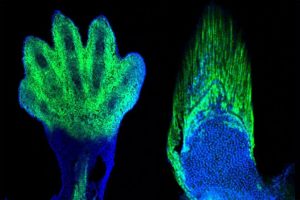
Credit: Andrew Gehrke and Marie Kmita
Have you ever wondered why our hands have exactly five fingers? Dr. Marie Kmita’s team certainly has. The researchers at the Institut de recherches cliniques de Montréal and Université de Montréal have uncovered a part of this mystery, and their remarkable discovery has just been published in the journal Nature.
A matter of evolution
We have known for several years that the limbs of vertebrates, including our arms and legs, stem from fish fins. The evolution that led to the appearance of limbs, and in particular the emergence of fingers in vertebrates, reflects a change in the body plan associated with a change of habitat, the transition from an aquatic environment to a terrestrial environment. How this evolution occurred is a fascinating question that goes all the way back to the work of Charles Darwin.
This August, researchers in Chicago, Dr. Neil Shubin and his team, demonstrated that two genes — hoxa13 and hoxd13 — are responsible for the formation of fin rays and our fingers. “This result is very exciting, because it clearly establishes a molecular link between fin rays and fingers,” said Yacine Kherdjemil, a doctoral student in Marie Kmita’s laboratory and first author of the article published in Nature.
However, the transition from fin to limb was not accomplished overnight. The fossil record indicates that our ancestors were polydactyl, meaning that they had more than five fingers, which raises another key question. Through what mechanism did evolution favor pentadactyly (five fingers) among current species?
One observation in particular caught the attention of Dr. Kmita’s team: “During development, in mice and humans, the hoxa11 and hoxa13 genes are activated in separate domains of the limb bud, while in fish, these genes are activated in overlapping domains of the developing fin,” said Marie Kmita, Director of the Institut de recherches cliniques de Montréal’S Genetics and Development research unit and Associate Research Professor in the Department of Medicine at the Université de Montréal.
In trying to understand the significance of this difference, Yacine Kherdjemil demonstrated that by reproducing the fish-type regulation for the hoxa11 gene, mice develop up to seven digits per paw, i.e., a return to ancestral status. Dr. Marie Kmita’s team also discovered the sequence of DNA responsible for the transition between fish- and mouse-type regulation for the hoxa11 gene. “It suggests that this major morphological change did not occur through the acquisition of new genes but by simply modifying their activities,” added Dr. Marie Kmita.
From a clinical point of view, this discovery reinforces the notion that malformations during fetal development are not only due to mutations in the genes and may come from mutations in sequences of DNA known as regulatory sequences. “At present, technical constraints do not allow for identifying this type of mutation directly in patients, hence the importance of basic research using animal models,” said Marie Kmita.
Reference:
Yacine Kherdjemil, Robert L. Lalonde, Rushikesh Sheth, Annie Dumouchel, Gemma de Martino, Kyriel M. Pineault, Deneen M. Wellik, H. Scott Stadler, Marie-Andrée Akimenko, Marie Kmita. Evolution of Hoxa11 regulation in vertebrates is linked to the pentadactyl state. Nature, 2016; DOI: 10.1038/nature19813
Note: The above post is reprinted from materials provided by Université de Montréal.










